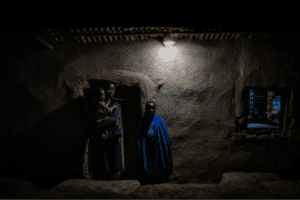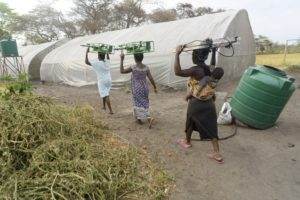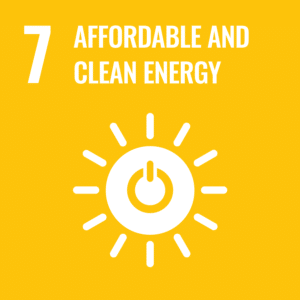
7 – Affordable and Clean Energy
The world is facing a humanitarian crisis. Today, 136 million people are in need of assistance after fleeing their homes due to war, persecution, natural disasters or catastrophic weather events. For many of these people, accessing an energy source is critical for survival.
The availability of energy affects our health, livelihoods, safety, and well-being. The topic of ‘humanitarian energy’ is fast gaining ground among disaster response and humanitarian practitioners globally, and rightly so; if we are to meet the seventh Sustainable Development Goal, to ‘ensure access to affordable, reliable, sustainable and modern energy for all’, we need to ensure no one is left in the dark when it comes to powering up. Read on to find out more about the importance of humanitarian energy for vulnerable communities and what can be done to illuminate their futures.
What does ‘Humanitarian Energy’ mean?
Access to energy has become a fundamental requirement of modern life. But the need to power up and switch on affects everyone, even in humanitarian contexts and emergencies, where people are displaced and forced to flee for their safety. The recognition of this basic need has led to a rapidly growing sub-sector known as ‘humanitarian energy’. Here’s an umbrella definition of the term:
“Institutions, policies, programmes, global initiatives, actions and activities which use a range of sustainable and fossil fuel energy sources in contexts of displacement, to meet the energy needs of people in camps and urban settings, self-settled refugees, host communities, and internally displaced people”. [1]
Humanitarian energy includes energy needs during emergencies as well as longer term situations. It aims to meet the needs of any community impacted by war, famine, violence, persecution, climate change, or natural disasters. [2]
Despite energy being recognised by the United Nations High Commissioner for Refugees (UNHCR) as ‘a basic need for everyone’, until recently the topic received relatively little focus in humanitarian practice and policy. Access to electricity, gas and other power sources or fuels for displaced people has not generally been prioritised among the global humanitarian community.
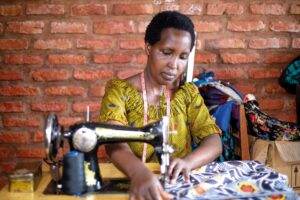
Esther’s business is thriving now she has electricity to power her sewing machine.
Current energy provision in refugee camps and camps for internally displaced people is often inefficient, polluting, unsafe for users, and harmful to the surrounding environment. The power sources for water pumps, community lighting and health clinics set up during humanitarian operations also rely heavily on unsustainable fossil fuels.
Fortunately, humanitarian practitioners are gradually becoming more switched on. Awareness of the importance of energy for enabling the security of people in vulnerable situations is growing ever stronger. [3]
The Global Platform for Action (GPA) on Sustainable Development in Displacement Settings, an initiative hosted by the UN, has a vision that, “displaced persons, host communities, and associated humanitarian response mechanisms have access to affordable, reliable, sustainable, and modern energy services by 2030”. [4]
The UNCHR has stressed that access to clean, sustainably produced energy should be universal. They also highlighted the role of better energy sources in improving the health and wellbeing of refugees and other displaced communities. [5]
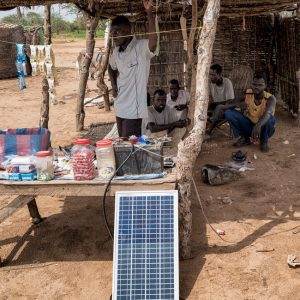
Access to renewable energy is set to transform life for displaced people
What difference does clean energy access make in refugee camps?
Energy is critical for essential activities such as cooking meals, heating shelters, cooling vaccines, charging mobile phones, and powering humanitarian operations. Lack of access to safe and sustainable energy can expose female refugees to risks of sexual and gender-based violence as they navigate poorly lit areas and may need to walk long distances alone to collect firewood.
Refugee camps are generally constructed as short-term, emergency shelters. However, as conflicts extend over the years with peaceful resolutions hard to reach, approximately 6.4 million displaced people end up living in these temporary spaces long-term. This often means there is a lack of infrastructure, a disconnection from national energy grids, and dwellings are not able to adequately meet the inhabitants’ energy needs.
The consequences of being without a reliable source of sustainable, safe energy are staggering. According to the UN’s Department for Economic and Social Affairs, only 10% of refugees worldwide have enough electricity for cooking, lighting and heating their homes; 80% rely on woodfire and fuels that emit harmful smoke. Around 20,000 people die prematurely each year due to the pollution this causes indoors. The environmental impact of this is equally urgent: an area the size of 49,000 football pitches is deforested by displaced families in refugee camps each year – because they have no other choice of fuel. Meanwhile, running schools is difficult without energy, and only 50% of refugee children have access to primary education. [6]
How can energy access help rebuild livelihoods?
When you are forced to flee from your home, land and business, it is very difficult to maintain consistent income. Livelihoods and economies can be utterly destroyed during natural disasters or violent conflict, leading to a loss of financial self-sufficiency for many refugees. A reliable energy source is vital in rebuilding businesses, creating jobs, and generating income. It’s necessary for empowering displaced people to reengage with education, work, and training. Powering homes, schools, health clinics and businesses enables refugees to flourish and move from reliance on aid to economic independence.
Practical Action’s work: powering up refugee lives
Building on our decades of work with communities developing lasting and locally owned solutions to the world’s toughest problems, we’ve been applying our ingenious ideas to refugee camps in Rwanda.
Working in partnership with UNHCR and supported by the IKEA Foundation, our Renewable Energy for Refugees (RE4R) project worked with 50,000 refugees in three camps as well as their host communities. Before the project, there was very little energy infrastructure in and around the camps, making it extremely difficult to cook meals, study at night, grow businesses and even move around the camp after dark. We helped families access finance, training, technology and expertise, as well as renewable energy.
The provision of energy has transformed lives: when surveyed, the refugee camp residents reported as follows:[7]
- 94% report that they feel safer in their home after dark
- 79% report that they are able to do recreational/leisure activities after dark
- 67% report that they are able to study after dark
- 69% report that they are able to do business or productive activates after dark
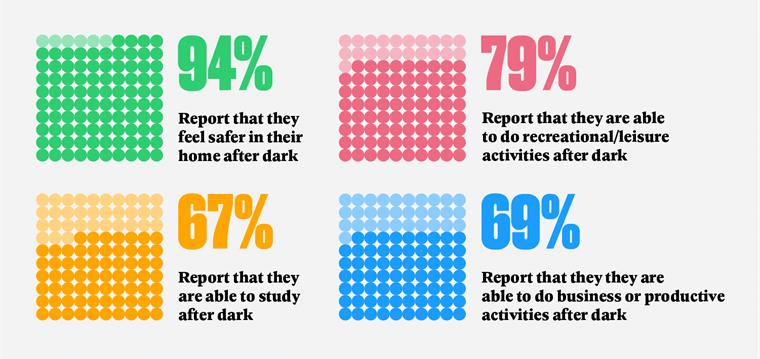
Providing sustainable electricity has allowed refugee families to light their homes and power small appliances such as phones, radios and other rechargeable devices. Street lighting has also improved safety within the camp after dark. We worked with local suppliers to offer affordable solar home systems to refugees living in the camps.
When schools were closed during the Covid-19 pandemic, students could continue their education via radio – powered by the renewable electricity supply. This was vital for children and young people. Students used radios or radio-enabled phones to tune in to the country’s daily radio classes with broadcasts taking place from 8.30am until 2pm daily on Radio Rwanda. These lessons were a vital link to the outside world, as well as a valuable learning resource, and a great illustration of the power of a successful humanitarian energy initiative. Read more about renewable energy in Rwanda.
Soon more displaced people will benefit from reliable energy, as plans to extend the project to five additional camps are underway. By harnessing the power of the sun, refugees can be safer, more connected, better informed and build their own income streams.
Meanwhile, we are bringing together refugee farmers and local farmers in a climate-resilient farming project. In an area with degraded soil which is prone to drought, Practical Action is installing solar-powered irrigation systems and training refugees and farmers to manage and maintain them. This will not only improve harvests and boost incomes, but also gradually boost soil productivity over time as vegetation cover increases and biodiversity returns.
References:
[1] http://heed-refugee.coventry.ac.uk/publications/definitions-and-differences-the-evolving-space-of-energy-access/
[2] https://www.humanitarianenergy.org/what-is-the-gpa/why-energy-is-important/
[3] https://jhumanitarianaction.springeropen.com/articles/10.1186/s41018-021-00102-x
[4] https://unitar.org/sustainable-development-goals/peace/our-portfolio/global-platform-action-gpa-sustainable-energy-displacement-settings
[5] https://sdgs.un.org/events/leaving-no-one-behind-energy-humanitarian-response-and-sustainable-development-7396
[6] https://sdgs.un.org/events/leaving-no-one-behind-energy-humanitarian-response-and-sustainable-development-7396
[7] https://practicalaction.org/news-media/2021/04/01/the-impact-of-covid-19-on-the-energy-use-of-refugee-households-in-rwanda/
